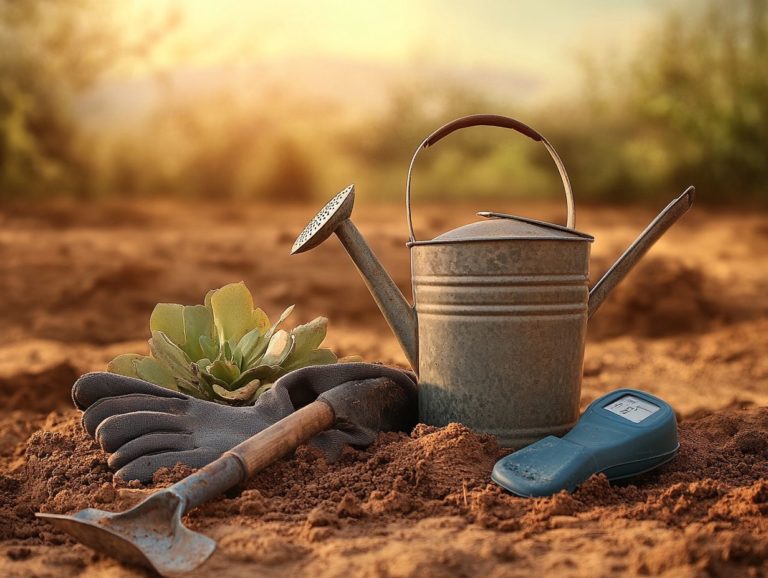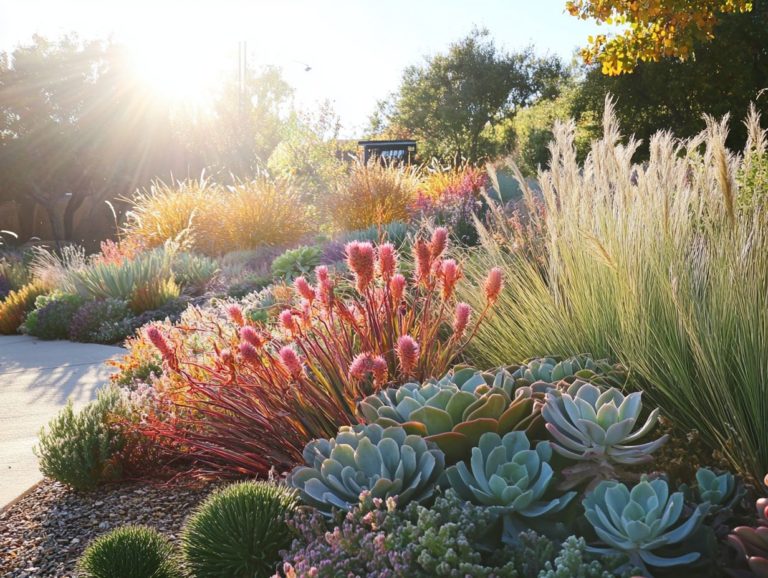What Are the Signs of Overwatering Drought Plants?
Understanding the delicate balance of watering is essential for the health of your plants. Both overwatering and drought can inflict damage on your greenery, leading to issues that hinder growth and vitality.
This guide delves into the causes and symptoms of these two extremes. It equips you with the knowledge to identify visual indicators and their impacts on plant health.
You ll also discover effective prevention techniques tailored to various plant types. By mastering the art of proper watering, you can keep your plants thriving beautifully.
Contents
- Key Takeaways:
- Understanding Overwatering and Drought in Plants
- Signs of Overwatering in Plants
- Signs of Drought in Plants
- Preventing Overwatering and Drought
- Frequently Asked Questions
- What Are the Signs of Overwatering Drought Plants?
- How can I tell if my plants are getting too much water?
- Can overwatering actually cause drought in plants?
- Are there any plants that are more susceptible to overwatering?
- What should I do if I suspect my plants are being overwatered?
- How can I prevent overwatering my plants in the future?
Key Takeaways:

- Overwatering and drought can both harm plant health and growth. It is important to understand the causes and symptoms of each.
- Signs of overwatering include yellowing leaves, wilting, and mold growth. Drought signs include dry, brittle leaves and stunted growth.
- Prevent overwatering and drought by using proper watering techniques and considering factors such as plant type and environment.
Understanding Overwatering and Drought in Plants
Overwatering and drought greatly affect plant health. It s crucial for any plant owner to understand these conditions.
Overwatering can cause root rot and weak leaves. Drought may lead to dehydration, yellowing leaves, and stunted growth.
Recognizing symptoms early helps maintain vibrant and healthy plants. This ensures your garden, whether indoors or outdoors, thrives beautifully.
Causes and Symptoms
The causes and symptoms of overwatering and underwatering differ. Both can profoundly impact your plants’ health and vitality.
Overwatering often reveals itself through signs like mushy leaves and yellow halos around the edges. In contrast, underwatering may present as dry soil and wilting leaves.
Understanding the specific conditions that lead to these issues is essential for any gardener. Improper watering routines often stem from forgetfulness or misjudging your plant’s needs based on the season.
Compact soil can trap excessive moisture, inviting root rot, especially in succulents that thrive in drier conditions. Meanwhile, annuals may show signs of wilting even when the soil feels dry.
Insufficient drainage can intensify both overwatering and underwatering symptoms. When water fails to drain properly, it can create an overly moist environment around the roots.
This prevents deeper roots from accessing the moisture they need. Regularly monitoring soil moisture is key to fostering a balanced environment for healthy growth.
Signs of Overwatering in Plants
Recognizing the signs of overwatering in your plants is crucial for preserving their vitality. Keep an eye out for these telltale signs!
Look for yellowing leaves, mushy textures, and the onset of root rot these can all suggest that it s time to reassess your watering routine.
Such symptoms tend to be especially noticeable in indoor plants and those nestled in poorly draining potting mixes. Excess moisture can linger and compromise their overall health.
Visual Indicators

Visual indicators of overwatering can offer you instant clues about your plants’ health. This allows you to take swift action. Symptoms such as yellowing leaves, mushy textures, and softness are clear signals that your plant might be drowning or grappling with poor drainage. Regularly inspecting your plants for these signs is essential for optimal care.
Different species react distinctly to these symptoms; for example, succulents, which thrive on minimal water, will show distress much sooner than more resilient shrubs. Soft, swollen leaves in succulents can lead to rot, while shrubs might just droop, masking the real issue. Pruning affected leaves promptly not only enhances the plant’s appearance but also redirects energy towards healthier growth.
Adjust your watering habits based on these indicators; it helps prevent further damage and fosters a lush, thriving green space.
Effects on Growth and Health
The effects of overwatering on your plants can be quite harmful, leading to severe issues such as root decay a condition where roots decay due to too much water and stunted growth. This is particularly true for indoor plants, which often lack adequate container drainage or proper air circulation needed for healthy soil conditions.
Over time, excessive moisture can create a perfect breeding ground for fungal infections, which can cause various plant diseases and swiftly compromise your plant’s vigor. Succulents, celebrated for their low moisture needs, are especially at risk; when they re drenched too often, their leaves can become mushy, and their root structure weakens. Similarly, perennials sitting in perpetually soggy soil may fail to thrive or even perish.
Don t fall into these pitfalls! Follow these tips:
- Adjust your watering frequency based on the season.
- Incorporate pots with drainage holes.
Utilizing well-draining soil mixtures can help you maintain optimal moisture levels, ensuring your succulents and perennials flourish beautifully.
Signs of Drought in Plants
Recognizing the signs of drought in your plants is just as crucial as spotting overwatering symptoms, as extended periods of drought can significantly impact their health and vitality.
Common indicators of dehydration include dry soil, wilting leaves, and browning edges on foliage clear signals that your plants aren t getting enough water to flourish.
By understanding these warning signs, you can take proactive steps to provide the care and hydration your plants truly deserve.
Visual Indicators
Visual indicators are your critical allies in identifying drought conditions that may be affecting your plants. Keep an eye out for common signs such as wilting leaves, dry soil, and browning edges these can escalate rapidly if left unchecked. By staying vigilant and regularly inspecting these visual cues, you can take timely action to restore your plants to their optimal health.
The way drought manifests can differ between plant species; for example, succulents often adopt a tight, shriveled appearance, whereas leafy plants may begin to curl or discolor. Understanding these nuances is essential for effective intervention.
To combat drought stress effectively, consider these strategies:
- Apply mulch around the base of your plants to retain moisture.
- Use deep watering techniques that encourage roots to delve deeper into the soil.
- Choose drought-resistant varieties to bolster resilience.
With these measures in place, you can ensure that your garden remains vibrant and thriving, even during dry spells.
Effects on Growth and Health

Embrace the challenge of nurturing your plants! The effects of drought on growth and health can be quite alarming, often leading to stunted development and compromised vitality in your plants.
When plants are battling drought, you might notice signs like succulent leaves losing their plumpness a clear signal that they aren t getting the moisture they need. In the short term, a lack of water can cause wilting and a decline in photosynthesis.
This ultimately diminishes the plant’s ability to flourish. Over time, extended drought conditions can weaken roots, making them more vulnerable to pests and diseases, which may result in irreversible damage.
To tackle these challenges, consider implementing strategies such as:
- Deep watering encourages roots to delve deeper into the soil.
- Using mulch helps retain moisture.
Selecting drought-resistant varieties can also bolster your garden’s resilience. This ensures it can weather dry spells without suffering lasting harm.
Preventing Overwatering and Drought
Preventing overwatering and drought is crucial for keeping your plants healthy. Mastering proper watering techniques can elevate your gardening game.
By establishing a consistent watering routine that considers the specific needs of each plant and seasonal variations, you can effectively sidestep the extremes of water stress. This thoughtful approach ensures your plants thrive, providing them with the balanced care they deserve.
Proper Watering Techniques
Utilizing proper watering techniques is essential for maintaining plant health and avoiding the pitfalls of both overwatering and drought. Establishing a consistent watering schedule and ensuring adequate moisture drainage can enhance the vitality of your plants.
Every type of plant has unique watering requirements. For example, succulents thrive in drier conditions and should only be watered when the soil is completely dry.
In contrast, ferns flourish in more humid environments and may require more frequent checks to maintain their moisture levels. Container drainage is equally crucial.
Ensuring that pots have sufficient drainage holes allows excess water to escape, helping to prevent root rot. A moisture meter is an invaluable tool for monitoring soil moisture levels.
This enables you to craft a personalized watering schedule that caters specifically to each plant’s needs and promotes optimal growth.
Factors to Consider for Different Plants
When considering the watering needs of different plants, several factors come into play, including their special features that help plants survive and specific soil moisture requirements.
For instance, drought-tolerant species may need less frequent watering than their moisture-dependent counterparts. Understanding the unique characteristics of various plant types can significantly enhance your watering efficiency.
Take succulents, for example their fleshy leaves thrive in arid conditions and often prefer dry soil. In contrast, annuals and perennials require regular moisture to support their growing seasons.
Environmental conditions such as temperature, humidity, and sunlight exposure also play crucial roles in determining how often you should check and replenish the soil. To adapt your watering habits effectively, consider investing in soil moisture meters or practicing the soak and dry method.
This way, you’ll ensure that the root systems receive optimal hydration without risking waterlogging.
Frequently Asked Questions

What Are the Signs of Overwatering Drought Plants?
The signs of overwatering drought plants can vary depending on the type of plant. However, common signs include yellowing or wilting leaves, root rot, and stunted growth. To better understand how to care for your plants, it’s also important to recognize the signs of underwatering drought plants.
How can I tell if my plants are getting too much water?
One clear sign of overwatering is soil that feels constantly wet or soggy. You might also notice a musty smell or white fungal growth on the soil surface.
Can overwatering actually cause drought in plants?
Yes, overwatering can cause drought-like conditions. Excess water can prevent roots from getting air and nutrients.
Are there any plants that are more susceptible to overwatering?
Yes, plants with shallow roots, like succulents and cacti, are more likely to suffer. These plants thrive in dry conditions and can easily become waterlogged.
What should I do if I suspect my plants are being overwatered?
If you see signs of overwatering, stop watering right away. Let the soil dry out, and consider repotting in fresh, well-draining soil.
How can I prevent overwatering my plants in the future?
Don’t let your plants suffer! Get to know their watering needs right away. Some need more water, while others require very little.
Use a simple tool to check if they need water before you pour.






